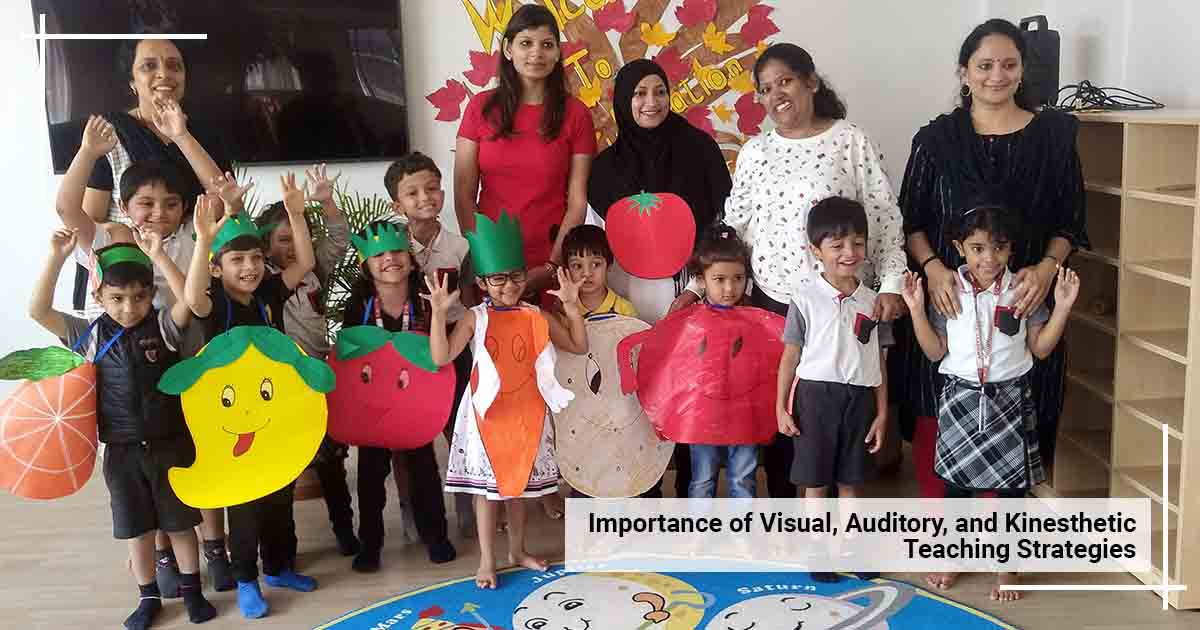Importance of Visual, Auditory, and Kinesthetic Teaching Strategies

Children are, in one sense, like an empty container. In their formative years, their mental abilities to learn come with a sense of plasticity that allows them to exercise their curiosities to learn, and to keep learning. Like playdough, the child’s mind can be molded and channelized to make the most of their abilities to explore, learn, and experiment with the world around them.
Teaching strategies enable and facilitate the child to create their own learning method; a hugely significant aspect of their individual mental landscapes. Child and developmental psychologists chart the development of the child’s fine and gross motor skills; skills that come to stay when they have learned the same within a controlled environment that seeks to bring out their best. Children learn from their immediate surroundings, by interacting with every sensory stimulus that they are presented with.
Adults hold the onus of creating an ecosystem that encourages the child to exercise their sensory receptors. Every sense organ in a child is passing on information to the brain. For example at Nalapad we use Dienes blocks as one example to help our students’ understand different concepts of math ranging from simple quantification to complex decimals, which in turn open windows to practice but also explore different equations, build autonomy and provide a stimulating environment for the student. Information is key to the learning mind and knowledge allows the mind to manipulate the same, by experimenting with lessons learned to further learn.
Visual and auditory receptors are acutely active participants in the young mind’s ability to engage with, process, and further assimilate the multiple sights and sounds they are each surrounded by. Children learn quickly, the languages they hear. We at Nalapad, assimilate different channels such as videos,presentations by students, drama and skits ,music and yoga that not only stimulate visual and auditory senses in children but makes the student recognize the importance of modulation of tone, pronunciation of words, usage of language. Children imitate and learn from actions that they see and perceive as actions that they can achieve too. Dance being the best form for students to not just listen, also requires paying attention to the beats and rhythm, it does not limit to listening but encourages to translate the same in through actions. Their milestones surround being able to identify with sights and sounds; lessons that often play a long-lasting impact on their minds. Our student assemblies are one of the many opportunities which provides students with opportunities to bring together their understanding of the world and express it in the best possible way.
Fine and gross motor skills are a significant contribution to the growth of the child. We at Nalapad, believe in tapping the right core at the right time, for which we incorporate with materials like using the sand tray, sandpaper letters, movable letters, puzzles, knobbed cylinders that helps in understanding different size, A pink tower are cube that needs to be arranged vertically from small to big are few activities which are a part of practice. Every adult is able to rely on the fine and gross motor skills they have learned as a child and more often than not, the environment that aids children with interactive mediums that help them move and channelize their movements to achieve productive results; may go a long way.
At Nalapad Academy, we ensure that every child is presented with multiple stimuli that achieve to engage with all the sensory receptors in every child. Children don’t need to be nudged to interact as much as they need encouragement to interact freely with their surroundings. They observe their environment and imbibe their subsequent experiences that help them learn to perceive. As they do, we are often encouraged to believe that children are gifts of nature. We watch them see, listen, move, and learn in ways that can be deeply profound, believing in same our classrooms are organised in manners where each class is equipped with corners that stimulates learning in form of having ‘Activity corners’ from Solving of different mathematical equations to making own equations to learning a ‘ new word’, correct usage of the word, rightly structuring the word in a sentence, ‘ Creative corners’ Using of dominios or Lego to bring out creativity in children, ‘Reflection corners’, from reflecting on what one is feeling at a time to reflecting on how their performance was- evaluating their own strengths and areas for improvement, recording their planning journals.
While there may be concerns that gadgets can spoil its users, today’s world is moving actively; towards growing into the pinnacle of its technological advancements. Oftentimes, gadgets used within controlled environments; help children exercise their abilities to learn. Our Nalapad students use their gadgets not only for research gathering of information but also to collaborate their understanding into drafts before presentations. They also use Ipad to exchange their respective work with each other as a form of peer review. They are able to exercise their sensory receptors and it contributes to learning, among multiple such teaching methods that we use.
To let our children learn by themselves and provide for them, the right ecosystem; may after all be the key to their growth.

